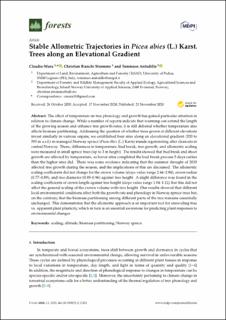Stable allometric trajectories in picea abies (L.) karst. trees along an elevational gradient
Peer reviewed, Journal article
Published version
Permanent lenke
https://hdl.handle.net/11250/3029149Utgivelsesdato
2020Metadata
Vis full innførselSamlinger
Sammendrag
The effect of temperature on tree phenology and growth has gained particular attention in relation to climate change. While a number of reports indicate that warming can extend the length of the growing season and enhance tree growth rates, it is still debated whether temperature also affects biomass partitioning. Addressing the question of whether trees grown at different elevations invest similarly in various organs, we established four sites along an elevational gradient (320 to 595 m a.s.l.) in managed Norway spruce (Picea abies (L.) Karts) stands regenerating after clearcuts in central Norway. There, differences in temperature, bud break, tree growth, and allometric scaling were measured in small spruce trees (up to 3 m height). The results showed that bud break and shoot growth are affected by temperature, as lower sites completed the bud break process 5 days earlier than the higher sites did. There was some evidence indicating that the summer drought of 2018 affected tree growth during the season, and the implications of this are discussed. The allometric scaling coefficients did not change for the crown volume (slope value range 2.66–2.84), crown radius (0.77–0.89), and tree diameter (0.89–0.96) against tree height. A slight difference was found in the scaling coefficients of crown length against tree height (slope value range 1.04–1.12), but this did not affect the general scaling of the crown volume with tree height. Our results showed that different local environmental conditions affect both the growth rate and phenology in Norway spruce trees but, on the contrary, that the biomass partitioning among different parts of the tree remains essentially unchanged. This demonstrates that the allometric approach is an important tool for unraveling true vs. apparent plant plasticity, which in turn is an essential awareness for predicting plant responses to environmental changes.

